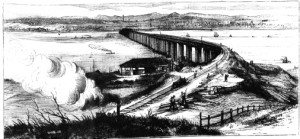On the last Sabbath day of 1879
At approximately 7.20 pm on Sunday 28 December 1879, a 1,060 yard stretch of the longest railway bridge in the world collapsed, killing 75 men, women and children. The Tay Bridge disaster sent shock waves through Victorian Britain, ended the career of its designer Sir Thomas Bouch and inspired William McGonnagal, Scotland’s worst poet, to write his famous poem The Tay Bridge Disaster.
During the 1850s and 1860s, the Caledonian Railway and the North British Railway were locked in a bitter struggle for dominance of Scottish railway industry. The 64-mile journey from Edinburgh to Dundee took three hours and 12 minutes to complete: by train from Edinburgh to Granton on Forth, by ferry to Burntisland, train to Tayport, another boat to Broughty Ferry then a third train to Dundee. Thomas Bouch had long dreamed of bridging the River Tay, and the North British Railway, which dominated in the east of Scotland, could see the commercial advantages. After much opposition and politicking, the idea of a bridge over the Tay caught the public’s imagination and the parliamentary bill authorising the construction of Thomas Bouch’s bridge received royal assent on 15 July 1870. The foundation stone of the new bridge was laid at Wormit, on the south bank of the Tay, on Saturday 22 July 1871. The river at this point was one mile wide. However, the line’s route at an angle across the river, and the bends necessary at either end, meant that the bridge would be almost two miles long.
Beautiful Railway Bridge of the Silv’ry Tay!
The men employed to build the bridge worked 12 hours a day and were paid up to 10d per hour (about 4p in today’s currency). The developing bridge became a tourist attraction and was visited by many professional engineers. The most famous visitor was General Ulysses S Grant, former president of the United States, who inspected the work in September 1877.
The bridge took 600 workmen six years to build and cost £300,000 and 20 lives. The inauguration of a passenger service took place on Friday 31 May 1878. It was a memorable day: the sun shone, flags flew, bands played, the militia marched, toasts and speeches were made and children lined the street cheering and sucking Tay Bridge rock.
The bridge was a success: the journey time to Edinburgh was cut by an hour, land values on the south bank of the river rose rapidly and the North British Railway Company now dominated the railways in the north of Scotland. In late June of 1879 Queen Victoria, on her way back from Balmoral, stopped briefly at the new Tay Bridge Station in Dundee and then crossed the bridge. Thomas Bouch received a knighthood.
Some harboured doubts about the bridge, however. Regular travellers complained that they could see the girders moving and that trains were exceeding the speed limit. Maintenance men found bolts that had fallen out and bolts that had rusted through, and there were holes in the girders.

